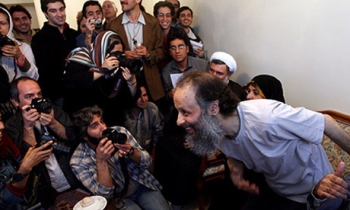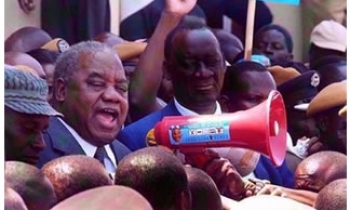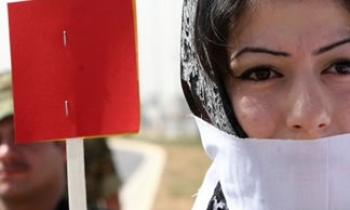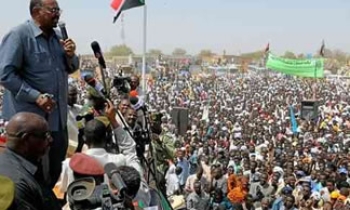Newly elected Argentine President Cristina Fernández is already a star in Santa Cruz, the southern provincial capital and hometown of her husband and former President Néstor Kirchner. Getting constant media attention, only the death of Pope John Paul II in April 2005 pushed her and Kirchner off the front page of daily El Periódico. All thanks to the huge official advertising revenue the paper has been bestowed upon ever since it was launched in March 2003.
El Periódico, the free, 8,000-circulation newspaper, distributed throughout the province of Santa Cruz, is part of a provincial media conglomerate led by Rudy Ulloa Igor, Kirchner’s former chauffer and one of his closest advisors. Ulloa’s media group — which comprises a radio station, two television stations, and two production companies — received more than 3 million pesos (US$960,000) in official advertising in 2006, says a special report by the Committee to Protect Journalists (CPJ)
The story of Ulloa’s media group is a glimpse of national phenomenon that CPJ has found damaging to press freedom. “Government at all levels uses official advertising to disseminate propaganda instead of relevant information for the citizen,†wrote O’Donnell, author of Propaganda K: Una Maquinaria de Promoción con Dinero del Estado. “But no president in history has invested as much as Kirchner in this venture.â€
In the months of national election, the Kirchner administration flooded the market with official advertising. In the first half of 2007, the government spent more than 164 million pesos ($51 million), an increase of 63 per cent over the same period in 2006, according to a report by the Asociación por los Derechos Civiles (ADC). The rate of increase of official advertising expenditure was many times more than the inflation rate of the country, the CPJ report said.
The end result was Fernández receiving favourable media coverage during election campaign and winning the presidential election with thumping majority. She grabbed 44.6 per cent of votes whereas her nearest rival, former lawmaker Elisa Carrio could only manage 22.6 per cent.
Government ads publicise things such as hospital services and school programmes and they inform citizens of obligations and rights. In some cases, the advertisements simply promote the routine activities of office-holders.
Besides El Periódico Austral, Santa Cruz has three other dailies: La Opinión Austral,the oldest paper in the province; Tiempo Sur; and Prensa Libre. Three private television stations and about four-dozen FM radio stations also compete for ads. Official advertising, particularly in provincial areas such as Santa Cruz, Government is considered as the “main advertising wallet.â€
There are no clear rules outlined for funds allocation and placement of advertising for the local as well as national government. Manipulative government advertising has become a prominent tool for biased coverage. News outlets that provide favourable coverage of incumbents get lots of ads; organisations that are critical get few or none.
National government advertising is bound by two decrees that leave officials with broad discretion to conduct all advertising transaction through Télam, the official agency, as well as setting priorities and assigning funds for ad campaigns. This leaves no room for objective, market-based approach to ad placement.
Due to lack of rules and guidelines laid down for distribution of government ads, the discretion in Santa Cruz cannot be blamed as improper as there is no measure to determine what is proper. “As there are no regulations, we implement the law of supply and demand,†Roque Alfredo Ocampo, the Santa Cruz minister of government told CPJ.
He also acknowledged that Ulloa’s media group receives more money than others, but he insisted that disparities are due to a system without rules. Data shows that Ulloa’s media group received 879,360 pesos ($275,000) in the first five months of 2007, a figure many times higher than that of other provincial outlets.
Miguel Carmona, El Periódico’s editor, however, denied that his paper is being rewarded as a friendly media outlet, and he downplayed any benefits the Ulloa group has derived from close relations with the government.
The influence of the “benefits†has been evident quite a few times in the province. The six-month strike by teachers and other state workers that began in March and later led to weekly protests drawing thousands onto the streets did not bother the local media for coverage, until it made headlines in the national press.
Angered by what they perceived as censorship in the official media, demonstrators organised a boycott of cable subscription to Ulloa’s Channel 2 and staged several protests in front of El Periódico Austral. With a few exceptions on radio, other private media outlets went out of their way to avoid criticising the government.
FM radio stations were the saving grace, which did uncompromising coverage of the conflict. Since the strike, FM has emerged an alternative media outlet, which voices the grievances of locals. FM News, a small privately owned station in RÃo Gallegos, in particular earned a reputation for critical coverage. Rolando Vera and Hugo Moyano, FM News owners, said that they have been harassed, threatened, and persecuted because of their critical reporting.
In another case, the nation’s largest magazine publisher, Editorial Perfil, filed suit in July 2006 alleging discrimination in government advertising in retaliation for the group’s critical reporting. The case is pending.
The debate has prompted Congress to consider six different bills aimed at ensuring more objective distribution of official advertising. Whatever legislation emerges, however, will come long after this year’s discriminatory advertising practices that have accomplished their purpose at the polls.









